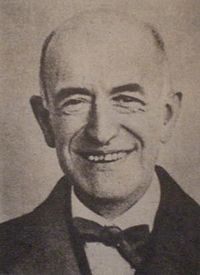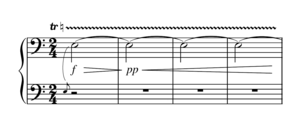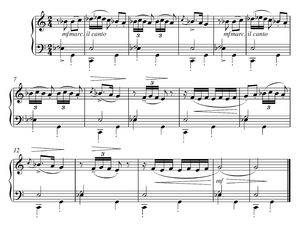- Ritual Fire Dance (Falla)
-
Manuel de Falla, composer of Ritual Fire Dance

The Danza ritual del fuego (Ritual Fire Dance) is a movement of the ballet El amor brujo[1] (close translation:The Magic Love), written by the Spanish composer Manuel de Falla in 1915. It was made popular by the composer's own piano arrangement.[2] The dance has a duration of about three to four and a half minutes.
The work was influenced by Rimsky-Korsakov's Flight of the Bumblebee[citation needed] due to its fast, repetitive trills and ornaments. The piece was also influenced by the traditional, religious ceremony of a fire dance. This is a dance which was used to worship the fire-god, and in which people would often jump through or leap around the fire.[3][4]
Contents
The story of the Ritual Fire Dance
Main article: El amor brujoIn De Falla's ballet, El amor brujo, a young Andalusian gypsy girl called Candela is haunted by the ghost of her dead husband. To get rid of him, all the gypsies make a large circle around their campfire at midnight. Candela then performs the Ritual Fire Dance. This causes the ghost to appear, with whom she then dances. As they whirl around faster and faster, the ghost is drawn into the fire, making it vanish forever.[5]
Instrumentation and transcriptions
The Ritual Fire Dance, and the ballet in its whole, has been transcribed many times since its original composition in 1915; often by Manuel de Falla himself.[6]
Form of transcription Instrumentation Date of transcription Original Composition Singing voice (the role of Candélas), flute (piccolo), oboe, horn, cornet, bells, piano, 2 first violins, 2 second violins, 2 violas, 2 cellos and double bass. 1915 Sextet 2 violins, viola, cello, double bass and piano. 1915 Full Orchestral 2 flutes (piccolo), oboe, 2 clarinets, bassoon, 2 horns, 2 trumpets, timpani (bells), piano and strings. 1916 Small Orchestral Chamber orchestra 1917 Ballet Voice (mezzo-soprano), 2 flutes (piccolo), oboe (cor anglais), 2 clarinets, bassoon, 2 horns, 2 trumpets, timpani, percussion, piano and strings. 1919 Piano Rendition Solo piano 1921 Concert ballet 2 flutes (piccolo), oboe (cor anglais), 2 clarinets, bassoon, 2 horns, 2 trumpets, timpani, percussion, piano and strings. 1925 Structure and analysis of the piano version
The piece has an Allo ma non troppo (Tempo:♩=126) and is in C major. The structure of the piece is an A B C A B C Coda form. The first section starts with 23 bars of trills from the piano. The dynamics of this section change frequently from pianissimo (pp) to mezzo forte (mf). For 14 bars, there is then a section for melody and accompaniment. Candélas then enters with two bars of "Ah!"s. The piano then follows with two bars of octave chords. There is then a question and answer section between Candélas and the piano, one bar at a time, for 17 bars. There are then trills for the piano for a further 8 bars. A quaver, quaver rest, quaver, quaver rest pattern follows with straight crotchets for 8 bars. A melody then comes in above the base rhythm for 24 bars. The piano then has a large section of chords and (mainly) quavers for 33 bars. There are then trills for one bar and another quaver, quaver rest, quaver, quaver rest pattern with a straight crotchet accompaniment for 4 bars. There are then 20 bars of more trills. A section with melody and accompaniment then follows. The above section then repeats. However, at the repeat is not complete, as the third movement is then cut off half way through by an ascending scale of triplets for four bars. Here the tempo changes to Pui mosso, ma guisto. This is the coda. Semi-quavers then follow for two three bar phrases of ascending scales. Candélas then has "Ah!"s at the start of every other following bar for the next four bars. These bars finish with semi-quavers and then an ascending scale. There are then crotchet chords for 15 bars. A descending arpeggio and low final note finish the piece.[7]
Recordings
CD Title Length (Minutes:Seconds) Record Label Recording Date Rubinstein Collection, Vol. 18[4] 3:23 RCA Red Seal 1947 500 Classical Masterpieces[4] 1:43 (Excerpt) Vox 1992 40 Popular Classics 4:13 Castle Select Records 1999 Falla: El Amor Brujo - Sombrero de tres picos - Noches en los jardines de España[8] 4:15 EMI Classics 1999 Falla: La Vida Breve; El amor brujo; etc. 4:11 EMI Classics 2001 Classical Music 101[4] 0:39 (Excerpt) RCA Red Seal 2004 De Falla; El Amor Brujo-El Retablo de Maese Pedro-Fantasia Baetica[9] 1:52 Mirare 2007 See also
References
- ^ Classical Notes
- ^ The Concise Oxford Dictionary of Music, 1996 by MICHAEL KENNEDY and JOYCE BOURNE at Encyclopedia.com
- ^ Fire Dance - Streetswing
- ^ a b c d Allmusic
- ^ Ritual Fire Dance by Manuel de Falla
- ^ Manuel de Falla Official Website
- ^ IMSLP Score
- ^ Amazon - Sombrero de tres picos
- ^ Amazon - El Retablo de Maese Pedro
External links
- Scores at IMSLP
- Manuel de Falla official site
- Orchestral Arrangement (Video)
- Piano Arrangement played by Arthur Rubinstein (Video)
- Guitar Duo Arrangement played by La Vita Williams Guitar Duo (Video)
Manuel de Falla Operas Los amores de la Inés · La vida breve · El retablo de Maese Pedro
Ballets El amor brujo · Ritual Fire Dance (from El amor brujo) · The Three-Cornered Hat
Orchestral  Manuel de Falla at Wikimedia Commons ·
Manuel de Falla at Wikimedia Commons ·  Wikipedia books: Manuel de FallaCategories:
Wikipedia books: Manuel de FallaCategories:- Compositions by Manuel de Falla
- 1915 compositions
Wikimedia Foundation. 2010.




